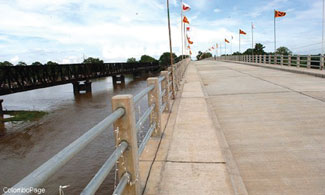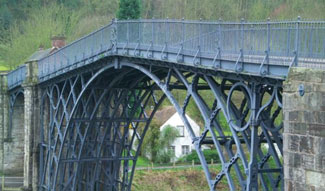|

Old And New
The Katugastota bridge was not the first iron bridge built by the
British in their new colony, Ceylon. Nearly 40 years earlier an iron
bridge had been built across the Mahaweli at Katugastota.
 |
|
Katugastota
bridge |
The Kandy - Matale road was opened in 1831, but there was no bridge
across the Mahaweli, only a ferry. This caused delays and losses to
planters especially at crop times. (Coffee was the main crop at this
time) because boats could not cope with the demand.
Twenty years passed before a bridge was even planned. On July 28,
1858 Governor Henry Ward ushered in the work on a bridge at Katugastota
a little up- stream from the ferry, where the Governor told the
Legislative Council, “Nature herself has made provision for the erection
of a bridge by a reef of rocks, presenting every facility for the piers
and an abundant supply of rock for the abutment.”
Dinner dance on the bridge
The work started on September 1, 1858 took 1 1/2 years. On March 1,
1860 Governor Ward declared open the bridge for traffic. Never before
had there been such a vast gathering of Europeans and locals in the
Central Province. It was an occasion for great rejoicing. The Governor
himself took part in a dinner dance on the bridge that night. It was a
landmark event worthy of celebrating in those early days, when there
weren’t all the machinery bridge-builders use today.
When this bridge was constructed in the mid-19th century, there
weren’t many iron bridges in England or Europe.
First ironbridge
 |
|
Manampitiya
Peace Bridge |
The first cast-ironbridge was made in England in a village now known
as Ironbridge in Shropshire in 1779. It was a 100 foot single span
bridge over the river Severn. The first boat built of iron was floated
in the Severn eight years later in 1878. Shropshire rapidly became the
greatest iron producing area in England.
Let’s get back to the Kelani bridge. Over the years the motor
vehicles going in and out of Colombo increased so much that the
Government decided to construct another bridge.
In September 1954 work commenced on another bridge further up-stream
and to the east of the railway line. It was started when Sir John
Kotelawela was Prime Minister, but when the work was completed, S.W.R.D.
Bandaranaike was Prime Minister. Bandaranaike didn’t declare open the
bridge.
He passed on that honour to a workman who had been working on the
bridge from the beginning. It was this workman who pressed the button to
open the bridge for traffic in the morning of February 3, 1959.
While the first bridge had a high class name - Victoria Bridge - this
new bridge was known simply as ‘Kelani Paalama.’ There was a very
popular Sinhala play by this name about 40 years ago. It is not being
staged now. The action takes place on the bridge - the Kelani Paalama
when people living on the river bank move on to the bridge with their
few belongings when the river is in spate (flooding).
 |
|
The Iron
bridge in Shropshire,England |
As the 20th century ended, the lifespan of the Victoria Bridge also
came to an end. In 1998 the old Victoria Bridge was completely
dismantled. A new bridge of pre-stressed concrete has been built with
aid from the Japanese Government. So this bridge is called Japanese
Friendship Bridge.
A number of old bridges have been replaced by new ones in the last 25
years. The most recent one is the Manampitiya Peace Bridge, over the
Mahaweli. Earlier, there was only one bridge here; it carried both motor
and rail transport. The railway line was in the centre with roads for
motor vehicles on either side.
When a train was on line all the motor traffic had to stop.The new
bridge is parallel to the old bridge which is on the Habarana,
Polonnaruwa, Batticaloa railway line.Constructed with aid from the
Japanese Government, it is the longest bridge now in Sri Lanka. Work on
the bridge commenced in October 2005, and was finished in September
2007. The bridge was declared open by the President in October 2007.
- Sumana Saparamadu.
|


